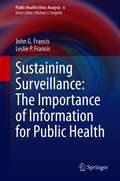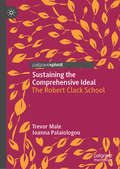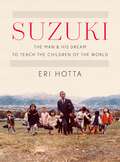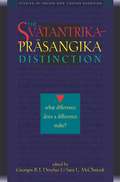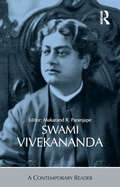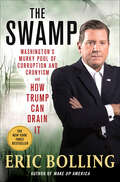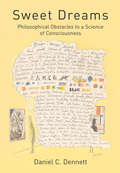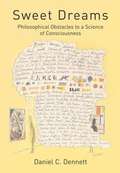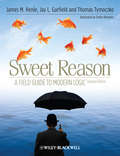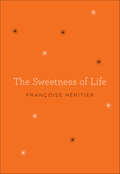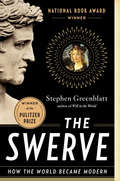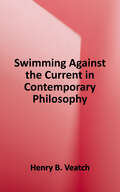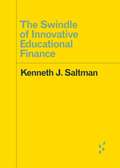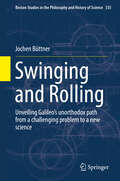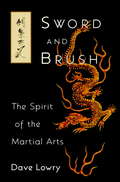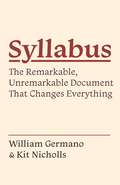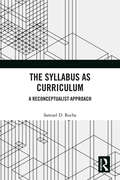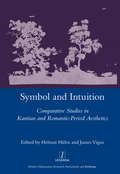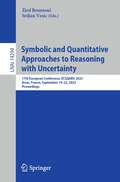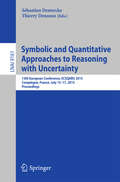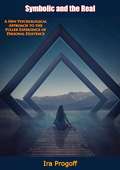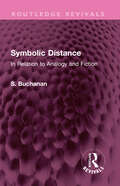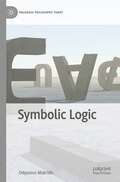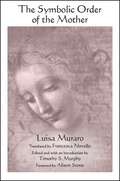- Table View
- List View
Sustaining Surveillance: The Importance of Information for Public Health (Public Health Ethics Analysis #6)
by John G. Francis Leslie P. FrancisThis book presents a comprehensive theory of the ethics and political philosophy of public health surveillance based on reciprocal obligations among surveillers, those under surveillance, and others potentially affected by surveillance practices. Public health surveillance aims to identify emerging health trends, population health trends, treatment efficacy, and methods of health promotion--all apparently laudatory goals. Nonetheless, as with anti-terrorism surveillance, public health surveillance raises complex questions about privacy, political liberty, and justice both of and in data use. Individuals and groups can be chilled in their personal lives, stigmatized or threatened, and used for the benefit of others when health information is wrongfully collected or used. Transparency and openness about data use, public involvement in decisions, and just distribution of the benefits of surveillance are core elements in the justification of surveillance practices. Understanding health surveillance practices, the concerns it raises, and how to respond to them is critical not only to ethical and trustworthy but also to publicly acceptable and ultimately sustainable surveillance practices. The book is of interest to scholars and practitioners of the ethics and politics of public health, bioethics, privacy and data technology, and health policy. These issues are ever more pressing in pandemic times, where misinformation can travel quickly and suspicions about disease spread, treatment efficacy, and vaccine safety can have devastating public health effects.
Sustaining the Comprehensive Ideal: The Robert Clack School
by Trevor Male Ioanna PalaiologouThis book explores the development of educational leadership within difficult contexts via the lens of a previously failing English secondary school in an area of urban poverty. Based on extensive interview data from 2012-2016, the authors demonstrate that the fundamental ethos underpinning the school’s improvement is a desire to meet the needs of young people in disadvantaged communities in order to equip them with the skills to allow them to transcend their situation. The authors posit that this school embodies the ‘comprehensive ideal’ of secondary education in England: that education should not be disadvantaged by background, and that the state should provide free and high quality education for all. This book will appeal to students and scholars of comprehensive education and schools in difficult contexts.
Suzuki: The Man and His Dream to Teach the Children of the World
by Eri HottaThe remarkable life of violinist and teacher Shinichi Suzuki, who pioneered an innovative but often-misunderstood philosophy of early childhood education—now known the world over as the Suzuki Method.The name Shinichi Suzuki is synonymous with early childhood musical education. By the time of his death in 1998, countless children around the world had been taught using his methods, with many more to follow. Yet Suzuki’s life and the evolution of his educational vision remain largely unexplored. A committed humanist, he was less interested in musical genius than in imparting to young people the skills and confidence to learn.Eri Hotta details Suzuki’s unconventional musical development and the emergence of his philosophy. She follows Suzuki from his youth working in his father’s Nagoya violin factory to his studies in interwar Berlin, the beginnings of his teaching career in 1930s Tokyo, and the steady flourishing of his practice at home and abroad after the Second World War. As Hotta shows, Suzuki’s aim was never to turn out disciplined prodigies but rather to create a world where all children have the chance to develop, musically and otherwise. Undergirding his pedagogy was an unflagging belief that talent, far from being an inborn quality, is cultivated through education. Moreover, Suzuki’s approach debunked myths of musical nationalism in the West, where many doubted that Asian performers could communicate the spirit of classical music rooted in Europe.Suzuki touched the world through a pedagogy founded on the conviction that all children possess tremendous capacity to learn. His story offers not only a fresh perspective on early childhood education but also a gateway to the fraught history of musical border-drawing and to the makings of a globally influential life in Japan’s tumultuous twentieth century.
Svatantrika-Prasangika Distinction
by Georges B.J. Dreyfus L. Sara McclintockMadhyamaka, or "Middle Way," philosophy came to Tibet from India and became the basis of all of Tibetan Buddhism. The Tibetans, however, differentiated two streams of Madhyamaka philosophy--Svatantrika and Prasangika. In this collection, leading scholars in the field address the distinction on various levels, including the philosophical import for both Indian and Tibetan Madhyamaka and the historical development of the distinction itself.
Swami Vivekananda: A Contemporary Reader
by Makarand R. ParanjapeSwami Vivekananda (1863–1902) popularised Vedanta in the West and reformed Hinduism in India. He also inspired the mass movement that made India a modern nation. In showcasing his life and work, this Reader balances the two main aspects of his life: the religious and the secular, the spiritual and the practical, the devotional and the rational. Included here are the most significant and representative texts from every major genre and phase — selections from his speeches, essays, letters, poems, translations, conversations, and interviews — arranged for easy reading and reference. With a scholarly Introduction highlighting his contemporary relevance, separate section introductions and a detailed biographical Chronology, this volume provides a rare insight into one of India’s greatest minds. This volume will interest scholars and students of modern Indian history, religion, literature, and philosophy as well as general readers.
The Swamp: Washington's Murky Pool of Corruption and Cronyism and How Trump Can Drain It
by Eric BollingHow Donald Trump can clear up political misconduct and corruption from the New York Times–bestselling author of Wake Up America.When Washington D.C. was first built, it was on top of a swamp that had to be drained. Donald Trump says it’s time to drain it again.In The Swamp, bestselling author and Fox News Channel host Eric Bolling presents an infuriating, amusing, revealing, and outrageous history of American politics, past and present, Republican and Democrat. From national political scandals to tempests in a teapot that blew up; bribery, blackmail, bullying, and backroom deals that contradicted public policies; cronyism that cost taxpayers hundreds upon hundreds of millions of dollars; and personal conduct that can only be described as regrettable, The Swamp is a journey downriver through the bayous and marshes of Capitol Hill and Foggy Bottom.The presidential election of 2016 was ugly, but it exposed a political, media, industry, and elite establishment that desperately wanted to elect a politician who received millions of dollars from terror-funding states over a businessman willing to tell the corrupt or incompetent, “You’re fired.”The book concludes with a series of recommendations for President Trump: practical, hard-headed, and concise ways to drain the swamp and force Washington to be more transparent, more accountable, and more effective in how it serves those who have elected its politicians and pay the bills for their decisions.Last year President Trump declared Wake Up America to be a “huge” book; Eric Bolling’s second book is sure to build on that success. Entertaining and timely, The Swamp is the perfect book for today’s political climate.
Sway: The Irresistible Pull of Irrational Behavior
by Ori Brafman Rom BrafmanWhat makes people act irrationally? This brilliant book shows how people do things against their best interests.
Sweet Dreams: Philosophical Obstacles to a Science of Consciousness (Jean Nicod Lectures)
by Daniel C. DennettIn the years since Daniel Dennett's influential Consciousness Explained was published in 1991, scientific research on consciousness has been a hotly contested battleground of rival theories—"so rambunctious," Dennett observes, "that several people are writing books just about the tumult." With Sweet Dreams, Dennett returns to the subject for "revision and renewal" of his theory of consciousness, taking into account major empirical advances in the field since 1991 as well as recent theoretical challenges.In Consciousness Explained, Dennett proposed to replace the ubiquitous but bankrupt Cartesian Theater model (which posits a privileged place in the brain where "it all comes together" for the magic show of consciousness) with the Multiple Drafts Model. Drawing on psychology, cognitive neuroscience, and artificial intelligence, he asserted that human consciousness is essentially the mental software that reorganizes the functional architecture of the brain. In Sweet Dreams, he recasts the Multiple Drafts Model as the "fame in the brain" model, as a background against which to examine the philosophical issues that "continue to bedevil the field."With his usual clarity and brio, Dennett enlivens his arguments with a variety of vivid examples. He isolates the "Zombic Hunch" that distorts much of the theorizing of both philosophers and scientists, and defends heterophenomenology, his "third-person" approach to the science of consciousness, against persistent misinterpretations and objections. The old challenge of Frank Jackson's thought experiment about Mary the color scientist is given a new rebuttal in the form of "RoboMary," while his discussion of a famous card trick, "The Tuned Deck," is designed to show that David Chalmers's Hard Problem is probably just a figment of theorists' misexploited imagination. In the final essay, the "intrinsic" nature of "qualia" is compared with the naively imagined "intrinsic value" of a dollar in "Consciousness—How Much is That in Real Money?"
Sweet Dreams: Philosophical Obstacles to a Science of Consciousness
by Daniel C. DennettSweet Dreams is a collection of essays and lectures written between 1999 and 2005 in which Dennett tries to freeze time and present a 'best' version of his evolving ideas...
Sweet Reason
by James M. Henle Jay L. Garfield Thomas TymoczkoSweet Reason: A Field Guide to Modern Logic, 2nd Edition offers an innovative, friendly, and effective introduction to logic. It integrates formal first order, modal, and non-classical logic with natural language reasoning, analytical writing, critical thinking, set theory, and the philosophy of logic and mathematics. An innovative introduction to the field of logic designed to entertain as it informs Integrates formal first order, modal, and non-classical logic with natural language reasoning, analytical writing, critical thinking, set theory, and the philosophy of logic and mathematics Addresses contemporary applications of logic in fields such as computer science and linguistics A web-site (www. wiley. com/go/henle) linked to the text features numerous supplemental exercises and examples, enlightening puzzles and cartoons, and insightful essays
The Sweetness of Life
by Françoise HéritierFrançoise Héritier’s international bestseller The Sweetness of Life is a celebration of the small, sweet moments that make life worth living—and the importance of taking the time to savor them.Busy juggling so many responsibilities in our overextended lives, we often miss the precious experiences that are pure joy and the actual experience of humanity: wild laughter, phone calls with loved ones, coffee in the sun, crisp fall evenings, running in warm rain, long conversations at twilight, cooking and savoring a good meal, watching a craftsman at work, getting together with friends we’ve missed.In this enchanting book—part letter, part prose poem, part charming and witty self-help guide— anthropologist Françoise Héritier lists with heartwarming and heartbreaking specificity all that we so easily overlook if we do not attend to the lightness and grace in our own lives.Filled with profound insight and down-to-earth wisdom, The Sweetness of Life is the perfect gift to to share with everyone you love.
The Swerve: How The World Became Modern
by Stephen GreenblattWinner of the Pulitzer Prize for Nonfiction • Winner of the National Book Award • New York Times Bestseller Renowned scholar Stephen Greenblatt brings the past to vivid life in what is at once a supreme work of scholarship, a literary page-turner, and a thrilling testament to the power of the written word. In the winter of 1417, a short, genial, cannily alert man in his late thirties plucked a very old manuscript off a dusty shelf in a remote monastery, saw with excitement what he had discovered, and ordered that it be copied. He was Poggio Bracciolini, the greatest book hunter of the Renaissance. His discovery, Lucretius’ ancient poem On the Nature of Things, had been almost entirely lost to history for more than a thousand years. It was a beautiful poem of the most dangerous ideas: that the universe functions without the aid of gods, that religious fear is damaging to human life, that pleasure and virtue are not opposites but intertwined, and that matter is made up of very small material particles in eternal motion, randomly colliding and swerving in new directions. Its return to circulation changed the course of history. The poem’s vision would shape the thought of Galileo and Freud, Darwin and Einstein, and—in the hands of Thomas Jefferson—leave its trace on the Declaration of Independence. From the gardens of the ancient philosophers to the dark chambers of monastic scriptoria during the Middle Ages to the cynical, competitive court of a corrupt and dangerous pope, Greenblatt brings Poggio’s search and discovery to life in a way that deepens our understanding of the world we live in now. “An intellectually invigorating, nonfiction version of a Dan Brown–like mystery-in-the-archives thriller.” —Boston Globe
Swimming Against the Current In Contemporary Philosophy: Occasional Essays and Papers (Studies in Philosophy and the History of Philosophy)
by Henry B. VeatchCollected essays of Prof. Henry B. Veatch, distinguished philosopher and teacher. Examines a variety of topics, including the works of Quine, Rorty, Gewirth, and Finnis as well as a variety of topics such as ethical egoism, libertarianism, the works of Aristotle and St. Thomas Aquinas, ethics, the study of the humanities, and the nature of natural law.
The Swindle of Innovative Educational Finance (Forerunners: Ideas First)
by Kenneth J. SaltmanHow &“innovative&” finance schemes skim public wealth while hijacking public governanceCharter school expansion. Vouchers. Scholarship tax credit programs. The Swindle of Innovative Educational Finance offers a new social theory to explain why these and other privatization policies and programs win support despite being unsupported by empirical evidence. Kenneth J. Saltman details how, under the guise of innovation, cost savings, and corporate social responsibility, new and massive neoliberal educational privatization schemes have been widely adopted in the United States. From a trillion-dollar charter school bubble to the Chan Zuckerberg Initiative to celebrities branding private schools, Saltman ultimately connects such schemes to the country&’s current crisis of truth and offers advice for resistance. Forerunners is a thought-in-process series of breakthrough digital works. Written between fresh ideas and finished books, Forerunners draws on scholarly work initiated in notable blogs, social media, conference plenaries, journal articles, and the synergy of academic exchange. This is gray literature publishing: where intense thinking, change, and speculation take place in scholarship.
Swinging and Rolling: Unveiling Galileo's unorthodox path from a challenging problem to a new science (Boston Studies in the Philosophy and History of Science #335)
by Jochen BüttnerThis volume explores the reorganisation of knowledge taking place in the course of Galileo's research process extending over a period of more than thirty years, pursued within a network of exchanges with his contemporaries, and documented by a vast collection of research notes. It has revealed the challenging objects that motivated and shaped Galileo's thinking and closely followed the knowledge reorganization engendered by theses challenges. It has thus turned out, for example, that the problem of reducing the properties of pendulum motion to the laws governing naturally accelerated motion on inclined planes was the mainspring for the formation of Galileo's comprehensive theory of naturally accelerated motion.
Sword and Brush: The Spirit of the Martial Arts
by Dave LowryThis moment of perfect clarity that is the force behind all the traditional Japanese arts--from archery to flower arranging--is celebrated here in Dave Lowry's exploration of the common principles shared by calligraphy and the martial arts. Forty-two examples of Lowry's calligraphy, accompanied by his essays, show how the way of the brush reflects the strategic principles of the way of the sword. Each calligraphy represents a term from the martial arts--such as do, the way, or wa, harmony. The accompanying text amplifies our understanding of the term, what it meant to Japanese warriors, and what it means to practitioners of calligraphy and the martial arts today. What becomes clear is that these two seemingly unrelated disciplines actually partake of the same profound elemental spirit.
Syllabus: The Remarkable, Unremarkable Document That Changes Everything (Skills for Scholars)
by William Germano Kit NichollsHow redesigning your syllabus can transform your teaching, your classroom, and the way your students learnGenerations of teachers have built their classes around the course syllabus, a semester-long contract that spells out what each class meeting will focus on (readings, problem sets, case studies, experiments), and what the student has to turn in by a given date. But what does that way of thinking about the syllabus leave out—about our teaching and, more importantly, about our students’ learning?In Syllabus, William Germano and Kit Nicholls take a fresh look at this essential but almost invisible bureaucratic document and use it as a starting point for rethinking what students—and teachers—do. What if a teacher built a semester’s worth of teaching and learning backward—starting from what students need to learn to do by the end of the term, and only then selecting and arranging the material students need to study?Thinking through the lived moments of classroom engagement—what the authors call “coursetime”—becomes a way of striking a balance between improv and order. With fresh insights and concrete suggestions, Syllabus shifts the focus away from the teacher to the work and growth of students, moving the classroom closer to the genuinely collaborative learning community we all want to create.
The Syllabus as Curriculum: A Reconceptualist Approach (Routledge Research in Education)
by Samuel D. RochaCan the syllabus constitute the curriculum? In this volume, Rocha explores curriculum theory through the lens of the syllabus. By critiquing curriculum studies and the entire field of education, overrun by the social sciences, Rocha provides an integrated vision of philosophy of education and curriculum theory, rooted in the humanities. Through an original reconceptualization, this text draws from a broad range of sources – ranging from Classical Antiquity to the present – offering a rich context for understanding curriculum as a philosophically salient concept, contained within the syllabus. The Syllabus as Curriculum features actual syllabi created and taught by the author in undergraduate and graduate courses at the University of British Columbia, Canada. These curated syllabi work as exemplars and media, supported by pedagogical commentary and context. Inspired by Augustine’s Confessions, each part of the book culminates in a metaphorical "garden," which serves as a meditation on the syllabus in three senses: correspondence, essay, and outline. An original, powerful, and corrective contribution to the literature on curriculum studies, this work invites teachers and scholars from across the foundations of education, especially philosophy of education, art education, and those invested in curriculum theory, to see their contribution in more direct and integral ways.
Symbol and Intuition: Comparative Studies in Kantian and Romantic-period Aesthetics
by Helmut Huehn"That a symbolic object or work of art participates in what it signifies, as a part within a whole, was a controversial claim discussed with particular intensity in the wake of Immanuel Kant's Critique of Judgment. It informed the aesthetic theories of a constellation of writers in Jena and Weimar around 1800, including Moritz, Goethe, Schelling and Hegel. Yet the twin concepts of symbol and intuition were not only tools of literary and mythological criticism: they were integral even to questions of epistemology and methodology in the fields of theology, metaphysics, history and natural philosophy. The international contributors to this volume further explore how both the explanatory potential and peculiar dissatisfactions of the symbol entered the Anglo-American discourse, focusing on Coleridge, Crabb Robinson and Emerson. Contemporary debates about the claims of symbolic as opposed to allegorical art are kept in view throughout."
Symbolic and Quantitative Approaches to Reasoning with Uncertainty: 17th European Conference, ECSQARU 2023, Arras, France, September 19–22, 2023, Proceedings (Lecture Notes in Computer Science #14294)
by Zied Bouraoui Srdjan VesicThis book constitutes the refereed proceedings of the 17th European Conference on Symbolic and Quantitative Approaches to Reasoning with Uncertainty, ECSQARU 2023, held in Arras, France, in September 2023. The 35 full papers presented in this volume were carefully reviewed and selected from 46 submissions. The papers are organized in topical sections about Complexity and Database Theory; Formal Concept Analysis: Theoretical Advances; Formal Concept Analysis: Applications; Modelling and Explanation; Semantic Web and Graphs; Posters.
Symbolic and Quantitative Approaches to Reasoning with Uncertainty
by Sébastien Destercke Thierry DenoeuxThis book constitutes the refereed proceedings of the 13th European Conference on Symbolic and Quantitative Approaches to Reasoning with Uncertainty, ECSQARU 2015, held in Compiègne, France, in July 2015. The 49 revised full papers presented were carefully reviewed and selected from 69 submissions and cover topics on decision theory and preferences; argumentation; conditionals; game theory; belief update; classification; inconsistency; graphical models; Bayesian networks; belief functions; logic; and probabilistic graphical models for scalable data analytics. Papers come from researchers interested in advancing the technology and from practitioners using uncertainty techniques in real-world applications. The scope of the ECSQARU conferences encompasses fundamental issues, representation, inference, learning, and decision making in qualitative and numeric uncertainty paradigms.
Symbolic and the Real: A New Psychological Approach to the Fuller Experience of Personal Existence
by Ira ProgoffIn this book the advanced conceptions of depth psychology are brought to bear upon the fundamental human problems of modern civilization. Dr. Progoff points out that one precondition for a significant development of creative personality is an expanded perception of reality beyond the current intellectual boundaries. It is not à question of ideas about what is real, but of the relation to reality that an individual can know in the depth and fullness of his personal existence. The focus of this book is a description and demonstration of how the capacities and sensitivities of modern persons can be enlarged so that they can relate their lives more fully to ultimate dimensions of reality.Dr. Progoff’s work as psychotherapist and lecturer, as Director of the Institute for Research in Depth Psychology at the Graduate School of Drew University, and as Founder/Director of Dialogue House, has led to major new techniques which are used both in resolving social problems and in enlarging spiritual awareness. The core of his work is contained in a trilogy of basic books. The Death and Rebirth of Psychology, the first of these, crystallizes the work of the great historical figures in depth psychology and sets the foundation for a new psychology of personal growth; Depth Psychology and Modern Man presents the evolutionary and philosophical perspectives and formulates basic concepts which make creative experience possible; and the third book; The Symbolic and the Real, pursues the practical and religious implications of these ideas. Dr. Progoff is also the author of Jung’s Psychology and Its Social Meaning and Jung, Synchronicity, and Human Destiny.“Dr. Progoff is not content with an analysis of the present crisis in human consciousness, but is more deeply concerned with the discovery of a way by which the individual may fulfill his responsibilities as a human being....This book is a frontier assault.”—Main Currents in Modern Thought
Symbolic Distance: In Relation to Analogy and Fiction (Routledge Revivals)
by S. BuchananFirst Published in 1932 Symbolic Distance presents the grammatical account of the structure of symbols and the description of the field within which fictions arise. The author argues that it seems improbable that distance should become an exact technical term in art criticism as long as the divorce between works of art and symbols is maintained. The book discusses important themes such as the analysis of fictions, genesis of fictions, and reduction of fictions. This is an interesting read for students of English literature.
Symbolic Logic (Palgrave Philosophy Today)
by Odysseus MakridisThis book provides a comprehensive introduction to the essential elements of standard (classical) symbolic logic. Key topics covered include: · The characteristic nature and scope of logic as a discipline · The construction of a series of distinctly named formal languages suitable for formal translation · Semantic models · The construction of decision procedures · The execution of proof-theoretic arrangements like natural deduction and proof-sequent systems The book covers both the semantics and proof theory of the standard sentential (propositional) logic and predicate (first-order) logic. Other topics covered include: parsing trees, extraction of alternative notations (for instance, Polish notation), Fitch-style proof-theory, sequent and ‘tree’ proof systems, comparisons and contrasts with intuitionistic logic, and presentations of predicate logic models. An ancillary chapter on elements of set theory is conveniently placed at the end and includes insights into the Zermelo-Fraenkel systematization of set theory. The philosophy of logic is also explored. Exercises in the text provide instruction on mathematical induction for the construction of formula, tests for the well-formedness of Polish notation, and functional completeness. Symbolic Logic is essential reading for all philosophy students taking intermediate level formal logic courses and will also appeal to diligent first year students of logic. The text is replete with exercises on both the formal machinery and the philosophical aspects of logic.
The Symbolic Order of the Mother (SUNY series in Contemporary Italian Philosophy)
by Luisa MuraroIn The Symbolic Order of the Mother Luisa Muraro identifies the bond between mother and child as ontologically fundamental to the development of culture and politics, and therefore as key to achieving truly emancipatory political change. Both corporeal development and language acquisition, which are the sources of all thinking, begin in this relationship. However, Western civilization has been defined by men, and Muraro recalls the admiration and envy she felt for the great philosophers as she strove to become one herself, as well as the desire for independence that opposed her to her mother. This conflict between philosophy and culture on the one hand and the relationship with the mother on the other constitutes the root of patriarchy's symbolic disorder, which blocks women's (and men's) access to genuine freedom. Muraro appeals to the feminist practice of gratitude to the mother and the recognition of her authority as a model of unconditional nurture and support that must be restored. This, she argues, is the symbolic order of the mother that must overcome the disorder of patriarchy. The mediating power of the mother tongue constitutes a symbolic order that comes before all others, for both women and men.
